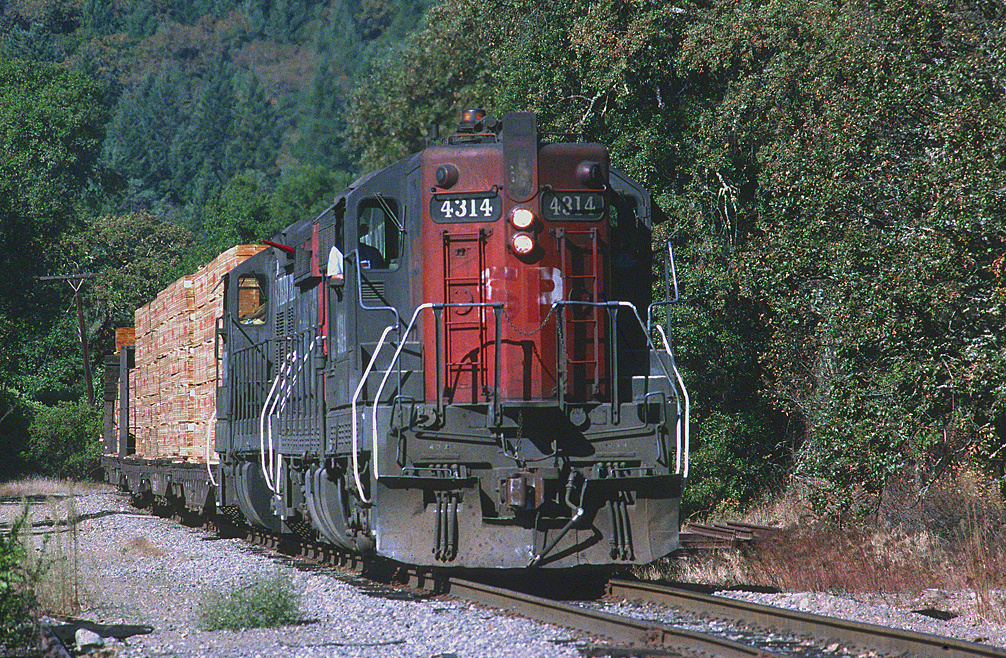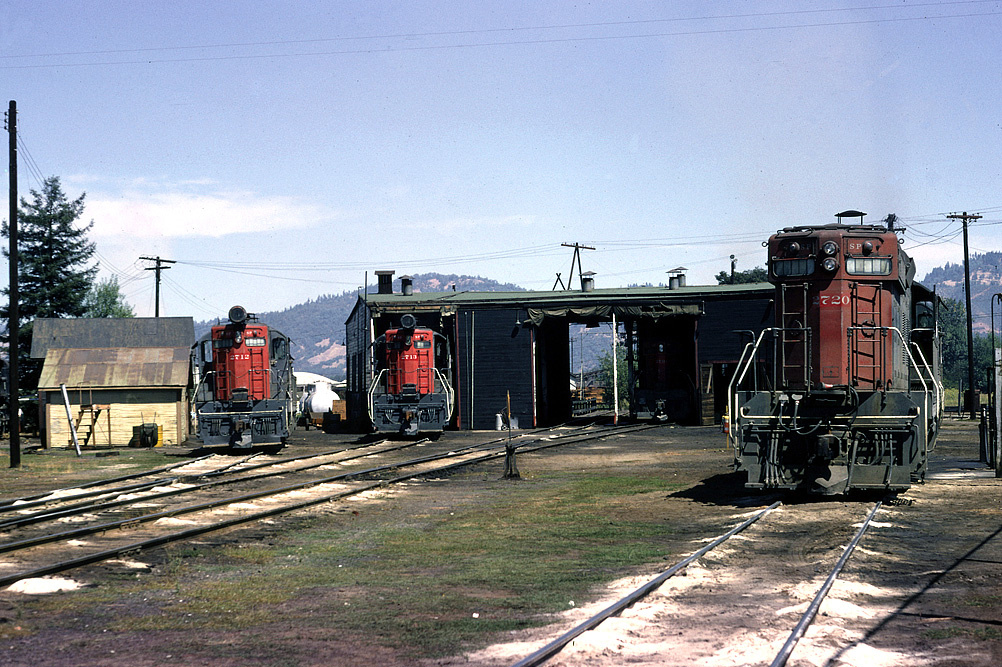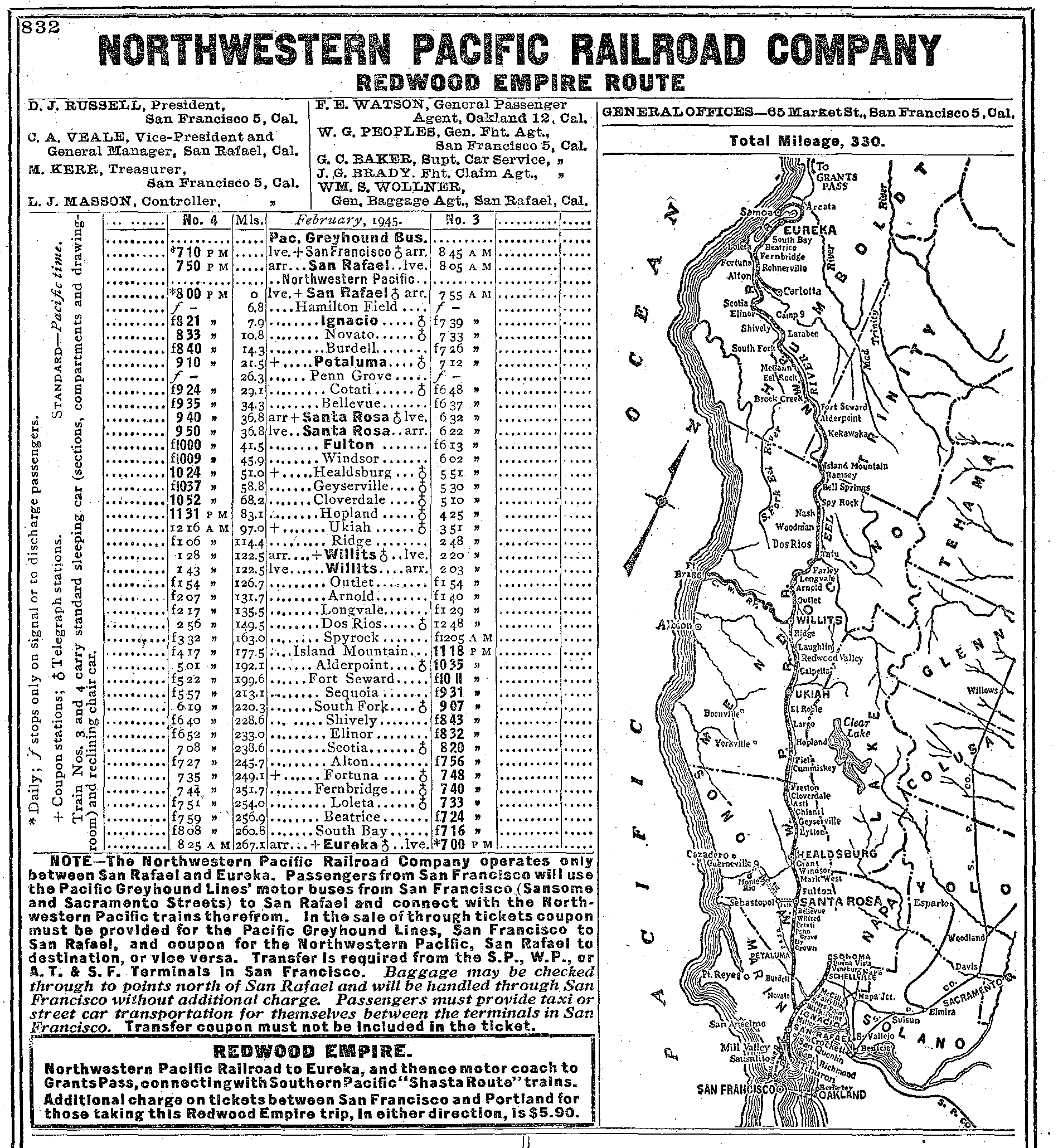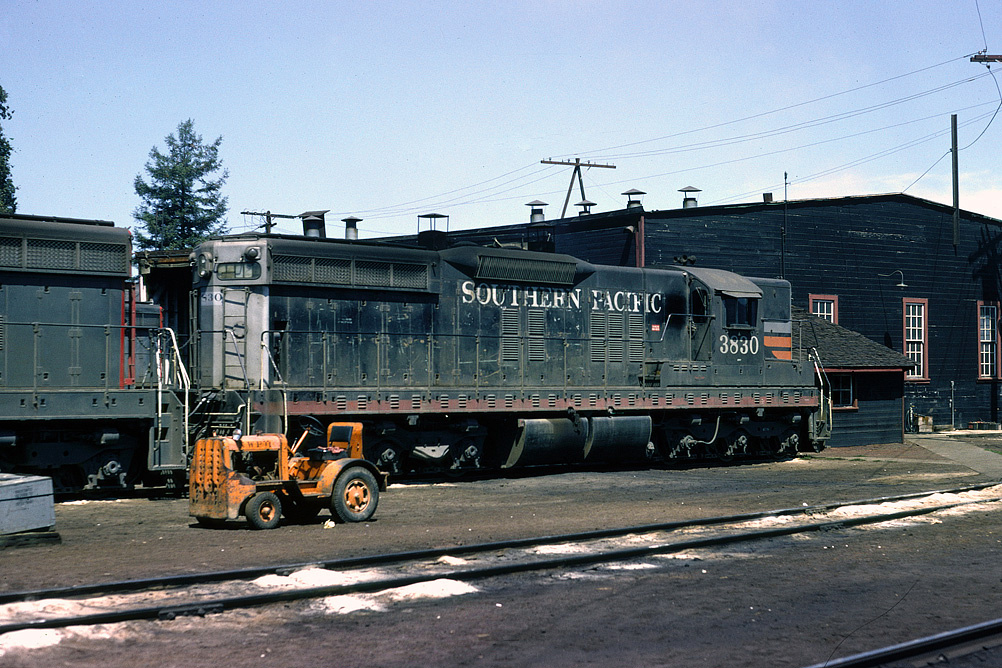Northwestern Pacific Railroad: History, Map, Timetable
Last revised: August 23, 2024
By: Adam Burns
The Northwestern Pacific Railroad (NWP) is a regional railroad that serves the North Coast of California. As originally built the system linked the Bay Area with Eureka with its primary freight being timber.
Today, 62 miles is still in service from Larkspur/San Rafael to the Sonoma County Airport in Windsor. In addition, the branch to Schellville is operated by Sonoma–Marin Area Rail Transit (SMART),
Originally established in the early 20th century, it was part of Southern Pacific Railroad until 1984, when it was sold to new regional operators.
The railroad faced significant challenges due to flooding and landslides, leading to periods of inactivity. However, it resumed freight service in 2011 under new ownership.
 During the second day of the California Northern's operation of the Northwestern Pacific, a pair of SD9s, led by #4314, have reached the top of Ridge Hill along the Willits to Schellville segment in December, 1993. Drew Jacksich photo.
During the second day of the California Northern's operation of the Northwestern Pacific, a pair of SD9s, led by #4314, have reached the top of Ridge Hill along the Willits to Schellville segment in December, 1993. Drew Jacksich photo.History
The Northwestern Pacific Railroad (NWP) occupies a significant chapter in the annals of American railroad history. Its formation in the early 20th century marked a new chapter in the United States' westward expansion. The railroad was built with the primary objective of servicing the bustling North Coast region of California.
The decision to construct the railroad was driven by the need to improve the transportation system in the Northwestern Pacific region. There was a growing demand for an efficient and reliable mode of transport to facilitate the movement of goods and people in the area. The NWP's creation aimed at fulfilling this demand, contributing immensely to the region's social and economic development.
Santa Fe and Southern Pacific
The railroad came into existence through the consolidation of several smaller railroads, mainly financed by powerful rail barons such as the Southern Pacific and the Santa Fe.
In his book, "History Of The Atchison, Topeka & Santa Fe Railway," author Keith Bryant, Jr. notes President Edward Ripley sought expansion into Northern California to tap the region's vast redwood timber stands.
These rich forests stretched some 450 miles north of San Francisco and were anywhere between one, to forty, miles wide. The Santa Fe had little coverage into Northern California except for singular lines reaching San Francisco and Oakland.
To reach these redwood stands, Ripley acquired the 42-mile Eel River & Eureka Railroad as well as the California Northern Railroad (Eureka - Arcata) during the early 20th century. He attempted to continue Santa Fe's access into the area when E.H. Harriman, who then controlled the Southern Pacific, took notice.
To stave off Ripley's attempt of entering SP's territory, Harriman began acquiring large blocks of AT&SF stock. The two companies eventually comprised, realizing the potential for immense profit and growth in the Northwestern Pacific region.
At A Glance
San Rafael - Willits - Eureka/Samoa Ignacio - Sonoma | |
They subsequently formed the Northwestern Pacific Railroad on January 8, 1907 to initially build between Willits and Chiveley (103 miles). Delayed by the Panic of 1907 this component was finally completed on July 1, 1915.
At its zenith, the Northwestern Pacific spanned an extensive network of approximately 271 miles from San Rafael to Eureka. It also made a connection with the California Western at Willits, another timber hauling road.
This impressive stretch made it a vital transportation artery in the North Coast region, providing an essential link between various urban and rural communities. It was nevertheless a difficult and expensive stretch of railroad requiring thirty tunnels (one of which was 4,000 feet in length) and many deep cuts and fills.
Unfortunately, despite its early success, the Northwestern Pacific Railroad began to suffer just over a decade after opening. These ranged from natural disasters to increased competition from road and air travel. These adversities led to a gradual decline in the operations of the railroad. The Santa Fe ultimately sold its share to the Southern Pacific in 1928.
 The sure-footed SD7s and SD9s were standard power on the Northwestern Pacific. Seen here are, from left to right, SD7s #2712, #2713, and #2720 at the Willits roundhouse in August, 1966. Drew Jacksich photo.
The sure-footed SD7s and SD9s were standard power on the Northwestern Pacific. Seen here are, from left to right, SD7s #2712, #2713, and #2720 at the Willits roundhouse in August, 1966. Drew Jacksich photo.Freight Traffic
In the railroad’s early days, it was a significant force driving local economies. The Northwestern Pacific facilitated the transport of commodities such as timber, livestock, and agricultural products, thereby contributing heavily to the economic growth of the North Coast region.
The Northwestern Pacific was not just about trade and commerce. It played a significant role in the social life of Northern California. It helped to bring communities closer and foster stronger socio-economic ties among the people in the region.
During its operational years, the Northwestern Pacific Railroad was a formidable rival to its major competitors, the Southern Pacific and the Santa Fe. Even though they shared common financial roots, the competition among these railroads was fierce and contributed to shaping the rail industry in the United States.
Timetable and System Map (1945)

However, the decline of the Northwestern Pacific Railroad served to strengthen its contemporaries. As the Northwestern Pacific Railroad’s fortunes dwindled, the Southern Pacific Railroad and Santa Fe Railroad consolidated their hold in the region, inheriting a portion of their competitor’s traffic and revenue.
In terms of technology, the Northwestern Pacific Railroad proved to be an innovator. It was among the railroads in the area that began to experiment with diesel locomotives before World War II, illustrating a forward-thinking approach to rail transportation.
Despite the plausible memories of dilapidation and abandonment, for railroad enthusiasts and scholars, the Northwestern Pacific Railroad remains a fascinating subject for exploration. It serves as a source of historical insight into the evolution of rail transportation on the North Coast.
The Northwestern Pacific Railroad stands as a poignant testament to the American West's growth and development. It is a silent reminder of the vital role railroads have played in shaping the United States into the nation it is today.
At its best, the Northwestern Pacific Railroad was more than a transport system; it represented the certainty of prosperity and growth in the Northwestern Pacific region. It provided jobs, nourished economies, and connected communities.
The remnants of the Northwestern Pacific Railroad serve as a tangible link to a past defined by innovation, ambition, and tremendous growth. Its tracks, bridges, and tunnels hold stories of a time when the railroad was the lifeblood of the communities it served.
The Northwestern Pacific Railroad may have ceased to exist as a fully operational company, but it remains part of the region's collective memory. The heritage and experiences that were shaped by the presence of this railroad continue to echo throughout the Northwestern Pacific region.
Within the landscape of the North Coast, the Northwestern Pacific Railroad has left indelible marks. It helped shape the region's geography and influenced the development of settlements and towns along its route.
The legacy of the Northwestern Pacific Railroad transcends its physical structures. It is engrained in the local folklore of numerous communities, in tales of the railroad's construction, and the legends of the people who worked tirelessly to ensure its success.
Looking at the Northwestern Pacific Railroad from a broader perspective, it was a testament to the indomitable American spirit of exploration and conquering new frontiers. The spirit that illuminated the construction and operation of this railroad is representative of the American dream.
The Northwestern Pacific Railroad stands as a testament to the resilience of the communities it served. Despite the challenges brought forth by natural disasters and economic downturns, the people of the North Coast have continuously found ways to repurpose and honor the remnants of this historic railroad.
The story of the Northwestern Pacific offers invaluable lessons in the transformative power of technology and the adaptability of societies. Though the physical entity has withered away, its essence lingers within the fabric of the North Coast.
By examining the lifecycle of the Northwestern Pacific Railroad, one can glean insights into the dynamics of boom and bust economies, the impact of technological shifts, and the influence of socio-economic factors on business viability.
Studying the Northwestern Pacific enhances our understanding of the factors that led to its creation and its ultimate downfall. It's an embodiment of the shifting patterns of demand and supply, and societal changes in modes of transport.
Despite its downfall, the Northwestern Pacific Railroad remains a relevant subject for research and study. Its history holds valuable lessons about financial investments, strategic planning, competitive dynamics, and meeting the changing demands of the consumer base.
From an environmental standpoint, the Northwestern Pacific Railroad’s abandonment and subsequent transformation into multi-use trails serve as a potential model for sustainable infrastructure reuse.
The Northwestern Pacific Railroad's rise and fall shed light on the impact of competition and the constant flux of industries, where old technologies give way to newer innovations, necessitating strategic adaptation to stay relevant.
The existence of the Northwestern Pacific Railroad and its abandonment provide a case study that allows policymakers, city planners, and railroad enthusiasts to understand the dynamics of building and maintaining such a massive transport infrastructure.
The Northwestern Pacific serves as a concrete example of how strategic business decisions, technological advancements, societal preferences, and geographical conditions can alter the course of an industry and a region's socio-economic landscape.
 Seen here is Southern Pacific SD9 #3830 in the "Black Widow" near the roundhouse in Willits, California in August, 1966. The SP's maintenance facility here is long gone. Drew Jacksich photo.
Seen here is Southern Pacific SD9 #3830 in the "Black Widow" near the roundhouse in Willits, California in August, 1966. The SP's maintenance facility here is long gone. Drew Jacksich photo.Legacy
The Northwestern Pacific's development from its inception, its period of prosperity, decline, and eventual closure offers valuable insights into the complex dynamics of economic development, and the role of transport infrastructure within it.
The Northwestern Pacific Railroad reminds us that old infrastructures, even when out of operation, can be repurposed for the betterment of communities, demonstrating the resilience and adaptive nature of societies.
In conclusion, the Northwestern Pacific Railroad, once a robust transportation artery, stands as a historic monument to the region it served. Even though it has ceased to operate, the railroad’s legacy continues to inspire and shape the Northwestern Pacific region, reminding us of the critical role railroads have played in the formation and shaping of America.
Current Status
The year 1992 marked the beginning of the end for the railroad as unstable track conditions led to the closure of several segments of the line. Consequently, there was a sharp decrease in freight traffic; a decline from which the Northwestern Pacific Railroad never recovered.
In terms of current status, part of the Northwestern Pacific Railroad has been reopened and currently operates freight trains between Windsor and Schellville under the North Coast Railroad Authority. However, the vast majority of the original line remains abandoned and in a state of disrepair due to lack of funding for necessary upgrades.
Despite its decline and eventual abandonment, the Northwestern Pacific Railroad left an indelible mark on the region it served. As a testament to its initial design and construction, several sections of the former Northwestern Pacific Railroad have been converted into multi-use paths, showcasing the adaptability and resilience of the original infrastructure.
Sources
- Bryant, Jr. Keith L. History Of The Atchison, Topeka & Santa Fe Railway. New York: Macmillan Publishing Company, 1974.
- Glischinski, Steve. Santa Fe Railway. St. Paul: Voyageur Press, 2008.
- Solomon, Brian. Southern Pacific Railroad. St. Paul: Voyageur Press, 2007.
- Yenne, Bill. History Of The Southern Pacific, The. New York: Bonanza Books, 1988.
Contents
Recent Articles
-
New York Christmas Train Rides In Corinth!
Dec 17, 25 01:00 PM
Today, the Saratoga, Corinth & Hudson Railway combines historic equipment, hands-on craftsmanship, and immersive family experiences—including its increasingly popular holiday rides, the Candy Cane Exp… -
Pennsylvania Christmas Train Rides In Hollidaysburg!
Dec 17, 25 12:39 PM
Today, the Everett Railroad offers scenic excursions, hands-on steam experiences, and one of the state’s most popular Christmas trains: the Santa Express. -
Wisconsin - Murder Mystery - Dinner Train Rides
Dec 17, 25 12:33 PM
Whether you're a fan of mystery novels or simply relish a night of theatrical entertainment, Wisconsin's murder mystery dinner trains promise an unforgettable adventure.



